Strategic Human Resource Management at Google: A Detailed Analysis
VerifiedAdded on 2021/04/21
|7
|1555
|48
Report
AI Summary
This report provides a comprehensive analysis of Google's strategic human resource management (HRM) practices. It begins with a brief overview of Google and then delves into key HRM areas, including recruitment and selection, training and development, reward structures and motivation, and retention policies. The report highlights Google's innovative and employee-centered approach to HRM, emphasizing its focus on hiring top talent, fostering a diverse workforce, and providing comprehensive training programs. It examines Google's unique reward systems, such as pay-for-performance and various bonus programs, and its emphasis on employee well-being and satisfaction through initiatives like the Kudos program. The report also explores Google's data-driven approach to employee retention, which prioritizes employee needs and provides tailored support to retain top talent. The conclusion summarizes how these strategic HRM practices have contributed to Google's competitive advantage in the market and its reputation as a top employer. The report utilizes academic research and Google's public information to support its analysis.
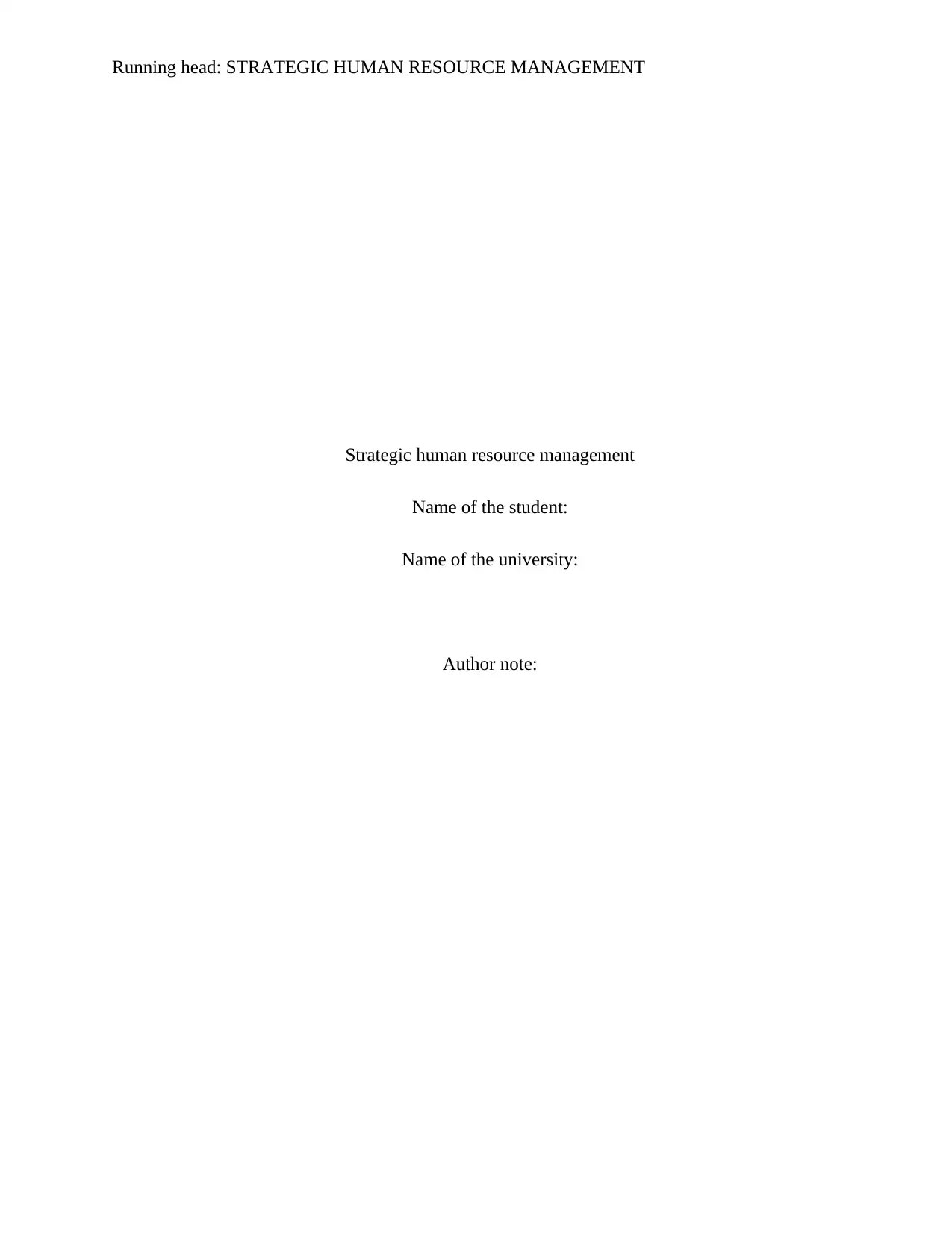
Running head: STRATEGIC HUMAN RESOURCE MANAGEMENT
Strategic human resource management
Name of the student:
Name of the university:
Author note:
Strategic human resource management
Name of the student:
Name of the university:
Author note:
Paraphrase This Document
Need a fresh take? Get an instant paraphrase of this document with our AI Paraphraser
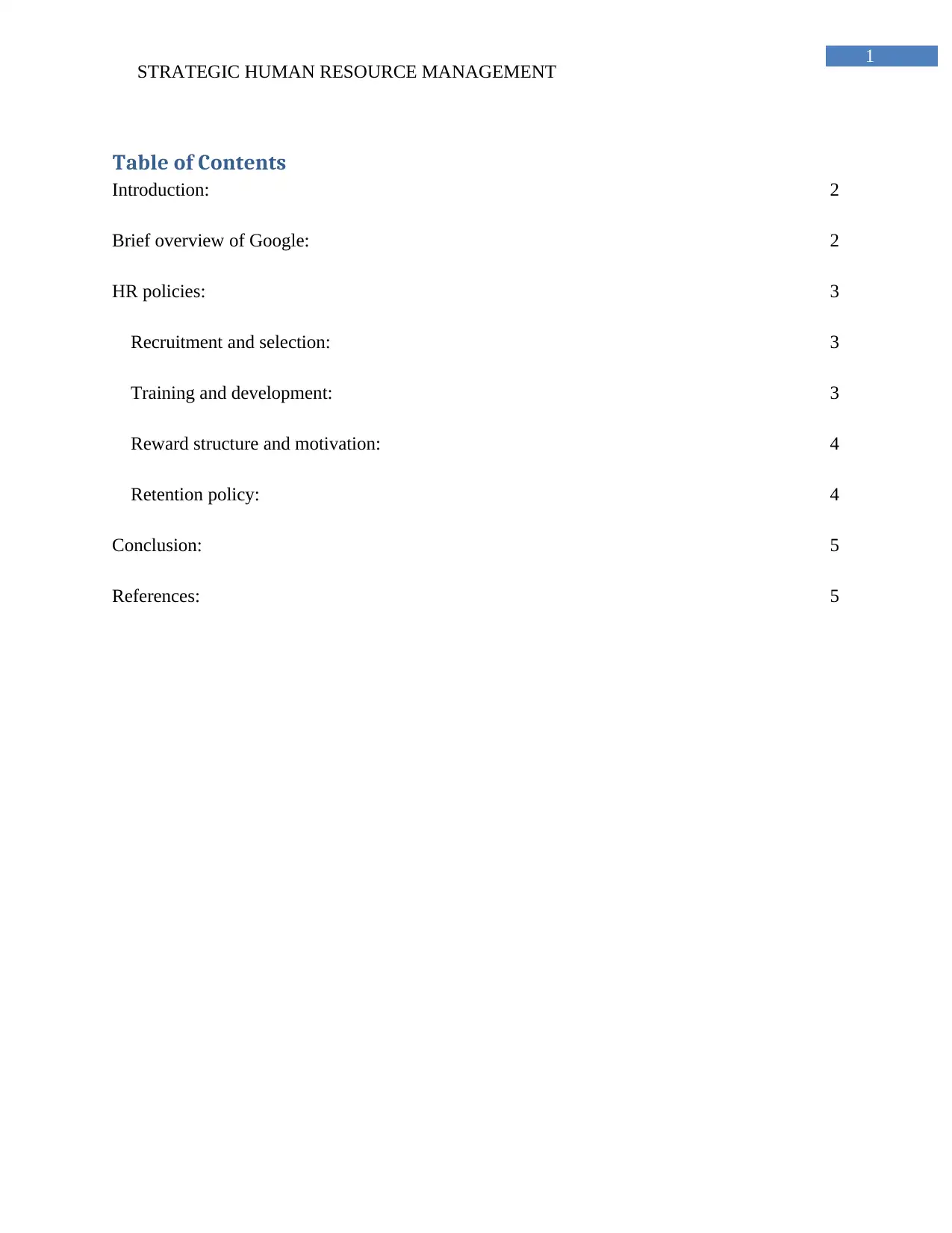
1
STRATEGIC HUMAN RESOURCE MANAGEMENT
Table of Contents
Introduction: 2
Brief overview of Google: 2
HR policies: 3
Recruitment and selection: 3
Training and development: 3
Reward structure and motivation: 4
Retention policy: 4
Conclusion: 5
References: 5
STRATEGIC HUMAN RESOURCE MANAGEMENT
Table of Contents
Introduction: 2
Brief overview of Google: 2
HR policies: 3
Recruitment and selection: 3
Training and development: 3
Reward structure and motivation: 4
Retention policy: 4
Conclusion: 5
References: 5

2
STRATEGIC HUMAN RESOURCE MANAGEMENT
Introduction:
For any organizational company, the entire productivity and performance is based on the
cooperation and collaborative harmony of the employees or staff of the organization. It has to be
mentioned in this context that the lack of a cooperative and engaged workforce working in an
organization can lead to productive loss and attrition in the company (Kehoe and Wright 2013).
The importance of strategic human resource management is extreme in both enhancing the
revenue statistics of the organization and contribute to the reduction of the turnover rate as well
This assignment will attempt to explore the human resource management activities of a
renowned and well established organization Google, emphasizing on recruitment and selection,
training and development, reward structure and motivation, and retention, and will attempt to
analyze how the human resource activities by this organization has helped to give them a
competitive edge in their market.
Brief overview of Google:
The journey to the top of its market for Google had been more than worth aspirations for the
rest of the competitors. It has been mentioned in the last few decades that the organization puts
innovation at the centre of its strategies and hence even in the sector of strategic human resource
management, the organization has managed to incorporate innovating and employee centred
principles. According to Saranya (2016), the organizational culture of Google is employee
centred, and the managerial hierarchy complies efficiently with the idea of putting the best
interests of the employees at the forefront of their policies and guidelines. One of the greatest
strategies of this organization had been to hire and retain the best and the brightest workforce,
and hence their recruitment policies are innovative, inclusive and reflects a very unique HR
STRATEGIC HUMAN RESOURCE MANAGEMENT
Introduction:
For any organizational company, the entire productivity and performance is based on the
cooperation and collaborative harmony of the employees or staff of the organization. It has to be
mentioned in this context that the lack of a cooperative and engaged workforce working in an
organization can lead to productive loss and attrition in the company (Kehoe and Wright 2013).
The importance of strategic human resource management is extreme in both enhancing the
revenue statistics of the organization and contribute to the reduction of the turnover rate as well
This assignment will attempt to explore the human resource management activities of a
renowned and well established organization Google, emphasizing on recruitment and selection,
training and development, reward structure and motivation, and retention, and will attempt to
analyze how the human resource activities by this organization has helped to give them a
competitive edge in their market.
Brief overview of Google:
The journey to the top of its market for Google had been more than worth aspirations for the
rest of the competitors. It has been mentioned in the last few decades that the organization puts
innovation at the centre of its strategies and hence even in the sector of strategic human resource
management, the organization has managed to incorporate innovating and employee centred
principles. According to Saranya (2016), the organizational culture of Google is employee
centred, and the managerial hierarchy complies efficiently with the idea of putting the best
interests of the employees at the forefront of their policies and guidelines. One of the greatest
strategies of this organization had been to hire and retain the best and the brightest workforce,
and hence their recruitment policies are innovative, inclusive and reflects a very unique HR
⊘ This is a preview!⊘
Do you want full access?
Subscribe today to unlock all pages.

Trusted by 1+ million students worldwide
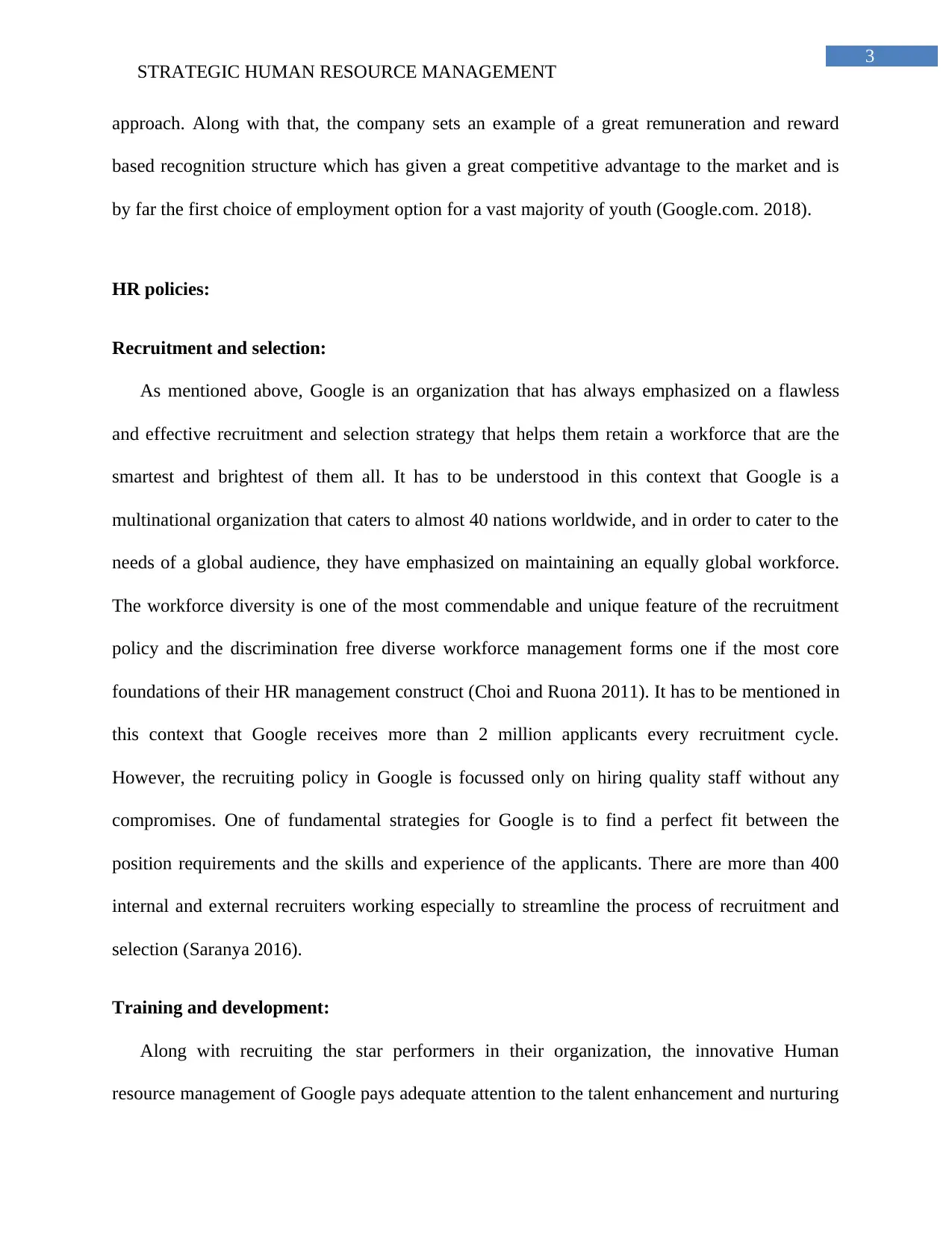
3
STRATEGIC HUMAN RESOURCE MANAGEMENT
approach. Along with that, the company sets an example of a great remuneration and reward
based recognition structure which has given a great competitive advantage to the market and is
by far the first choice of employment option for a vast majority of youth (Google.com. 2018).
HR policies:
Recruitment and selection:
As mentioned above, Google is an organization that has always emphasized on a flawless
and effective recruitment and selection strategy that helps them retain a workforce that are the
smartest and brightest of them all. It has to be understood in this context that Google is a
multinational organization that caters to almost 40 nations worldwide, and in order to cater to the
needs of a global audience, they have emphasized on maintaining an equally global workforce.
The workforce diversity is one of the most commendable and unique feature of the recruitment
policy and the discrimination free diverse workforce management forms one if the most core
foundations of their HR management construct (Choi and Ruona 2011). It has to be mentioned in
this context that Google receives more than 2 million applicants every recruitment cycle.
However, the recruiting policy in Google is focussed only on hiring quality staff without any
compromises. One of fundamental strategies for Google is to find a perfect fit between the
position requirements and the skills and experience of the applicants. There are more than 400
internal and external recruiters working especially to streamline the process of recruitment and
selection (Saranya 2016).
Training and development:
Along with recruiting the star performers in their organization, the innovative Human
resource management of Google pays adequate attention to the talent enhancement and nurturing
STRATEGIC HUMAN RESOURCE MANAGEMENT
approach. Along with that, the company sets an example of a great remuneration and reward
based recognition structure which has given a great competitive advantage to the market and is
by far the first choice of employment option for a vast majority of youth (Google.com. 2018).
HR policies:
Recruitment and selection:
As mentioned above, Google is an organization that has always emphasized on a flawless
and effective recruitment and selection strategy that helps them retain a workforce that are the
smartest and brightest of them all. It has to be understood in this context that Google is a
multinational organization that caters to almost 40 nations worldwide, and in order to cater to the
needs of a global audience, they have emphasized on maintaining an equally global workforce.
The workforce diversity is one of the most commendable and unique feature of the recruitment
policy and the discrimination free diverse workforce management forms one if the most core
foundations of their HR management construct (Choi and Ruona 2011). It has to be mentioned in
this context that Google receives more than 2 million applicants every recruitment cycle.
However, the recruiting policy in Google is focussed only on hiring quality staff without any
compromises. One of fundamental strategies for Google is to find a perfect fit between the
position requirements and the skills and experience of the applicants. There are more than 400
internal and external recruiters working especially to streamline the process of recruitment and
selection (Saranya 2016).
Training and development:
Along with recruiting the star performers in their organization, the innovative Human
resource management of Google pays adequate attention to the talent enhancement and nurturing
Paraphrase This Document
Need a fresh take? Get an instant paraphrase of this document with our AI Paraphraser
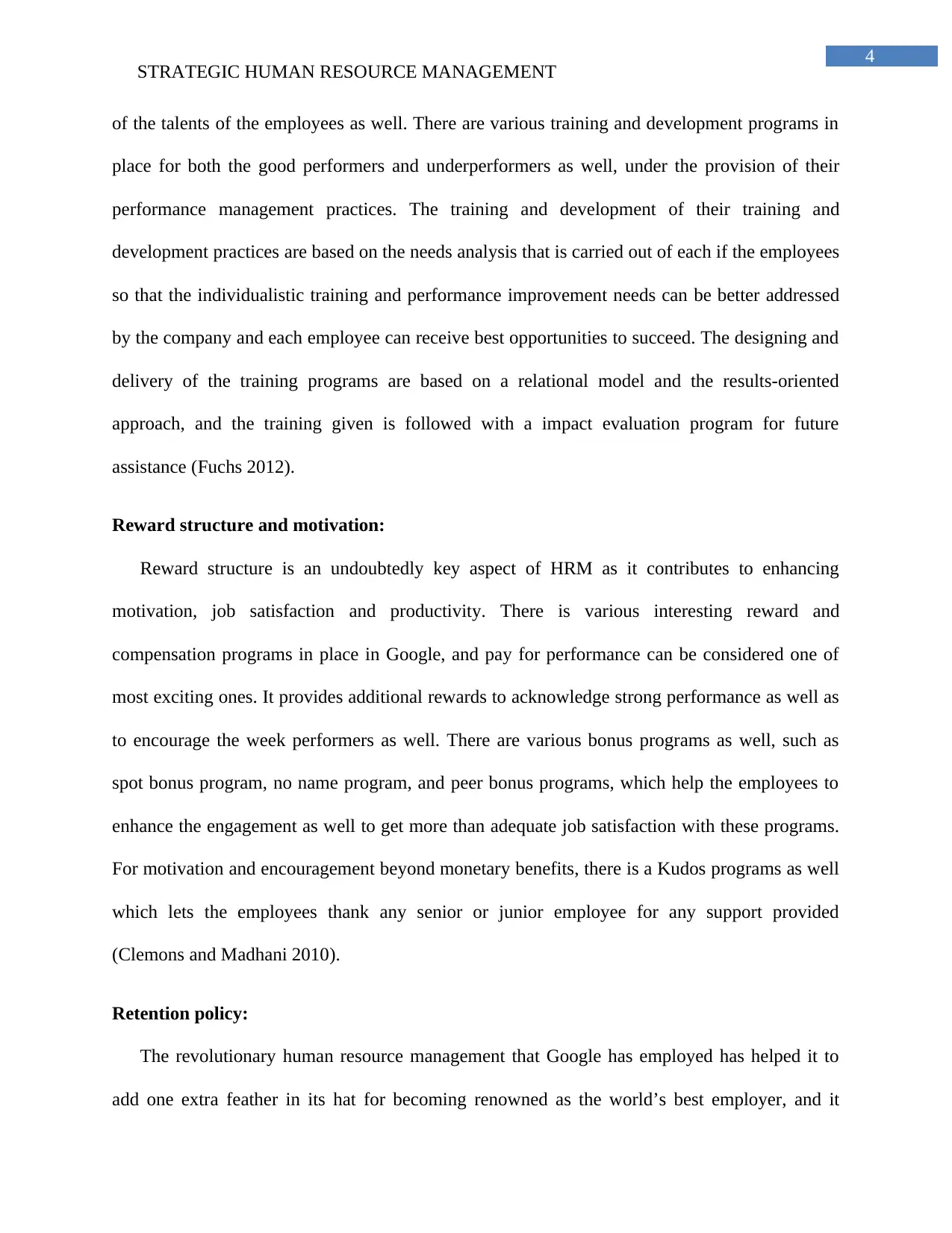
4
STRATEGIC HUMAN RESOURCE MANAGEMENT
of the talents of the employees as well. There are various training and development programs in
place for both the good performers and underperformers as well, under the provision of their
performance management practices. The training and development of their training and
development practices are based on the needs analysis that is carried out of each if the employees
so that the individualistic training and performance improvement needs can be better addressed
by the company and each employee can receive best opportunities to succeed. The designing and
delivery of the training programs are based on a relational model and the results-oriented
approach, and the training given is followed with a impact evaluation program for future
assistance (Fuchs 2012).
Reward structure and motivation:
Reward structure is an undoubtedly key aspect of HRM as it contributes to enhancing
motivation, job satisfaction and productivity. There is various interesting reward and
compensation programs in place in Google, and pay for performance can be considered one of
most exciting ones. It provides additional rewards to acknowledge strong performance as well as
to encourage the week performers as well. There are various bonus programs as well, such as
spot bonus program, no name program, and peer bonus programs, which help the employees to
enhance the engagement as well to get more than adequate job satisfaction with these programs.
For motivation and encouragement beyond monetary benefits, there is a Kudos programs as well
which lets the employees thank any senior or junior employee for any support provided
(Clemons and Madhani 2010).
Retention policy:
The revolutionary human resource management that Google has employed has helped it to
add one extra feather in its hat for becoming renowned as the world’s best employer, and it
STRATEGIC HUMAN RESOURCE MANAGEMENT
of the talents of the employees as well. There are various training and development programs in
place for both the good performers and underperformers as well, under the provision of their
performance management practices. The training and development of their training and
development practices are based on the needs analysis that is carried out of each if the employees
so that the individualistic training and performance improvement needs can be better addressed
by the company and each employee can receive best opportunities to succeed. The designing and
delivery of the training programs are based on a relational model and the results-oriented
approach, and the training given is followed with a impact evaluation program for future
assistance (Fuchs 2012).
Reward structure and motivation:
Reward structure is an undoubtedly key aspect of HRM as it contributes to enhancing
motivation, job satisfaction and productivity. There is various interesting reward and
compensation programs in place in Google, and pay for performance can be considered one of
most exciting ones. It provides additional rewards to acknowledge strong performance as well as
to encourage the week performers as well. There are various bonus programs as well, such as
spot bonus program, no name program, and peer bonus programs, which help the employees to
enhance the engagement as well to get more than adequate job satisfaction with these programs.
For motivation and encouragement beyond monetary benefits, there is a Kudos programs as well
which lets the employees thank any senior or junior employee for any support provided
(Clemons and Madhani 2010).
Retention policy:
The revolutionary human resource management that Google has employed has helped it to
add one extra feather in its hat for becoming renowned as the world’s best employer, and it

5
STRATEGIC HUMAN RESOURCE MANAGEMENT
extends towards the sector for employee retention as well. It has to be understood that in most
cases the employees are treated as nothing but a resource for the organizations to exploit, in case
of Google on the other hand, is a striking contrast in the sea of organizations treating their staff
as a means to an end. This organization does not run a human resource; it runs a people
operations where the talent that they have recruited so meticulously is valued above everything
which is reflected in either retention policy, along with that, they also incorporate rigorous data
analysis in improving their retention. Their decision making framework is completely employee
centred and is unique from the assumption and relationship based retention policies that are used
in the organizations as well. Google and its decision making framework relies completely on
statistics and algorithms; Google takes pride upon the star ‘Googlers’ or their brilliant and
hardworking staff and they are given a steady and step by step counselling and motivation
process to ensure that the company does not lose the talents they have acquired (Saranya 2016).
Conclusion:
The concept of strategic human resource management for Google is extremely employee
centred and outcome oriented. The importance of an employee centred culture and associated
strategic human resource management is extreme in providing a focused manpower to the
organization and providing a competitive edge to the company as well. That is the reason the
Google has attained the title of the best employer in the market along with enjoying the
monopoly in the tech market.
STRATEGIC HUMAN RESOURCE MANAGEMENT
extends towards the sector for employee retention as well. It has to be understood that in most
cases the employees are treated as nothing but a resource for the organizations to exploit, in case
of Google on the other hand, is a striking contrast in the sea of organizations treating their staff
as a means to an end. This organization does not run a human resource; it runs a people
operations where the talent that they have recruited so meticulously is valued above everything
which is reflected in either retention policy, along with that, they also incorporate rigorous data
analysis in improving their retention. Their decision making framework is completely employee
centred and is unique from the assumption and relationship based retention policies that are used
in the organizations as well. Google and its decision making framework relies completely on
statistics and algorithms; Google takes pride upon the star ‘Googlers’ or their brilliant and
hardworking staff and they are given a steady and step by step counselling and motivation
process to ensure that the company does not lose the talents they have acquired (Saranya 2016).
Conclusion:
The concept of strategic human resource management for Google is extremely employee
centred and outcome oriented. The importance of an employee centred culture and associated
strategic human resource management is extreme in providing a focused manpower to the
organization and providing a competitive edge to the company as well. That is the reason the
Google has attained the title of the best employer in the market along with enjoying the
monopoly in the tech market.
⊘ This is a preview!⊘
Do you want full access?
Subscribe today to unlock all pages.

Trusted by 1+ million students worldwide
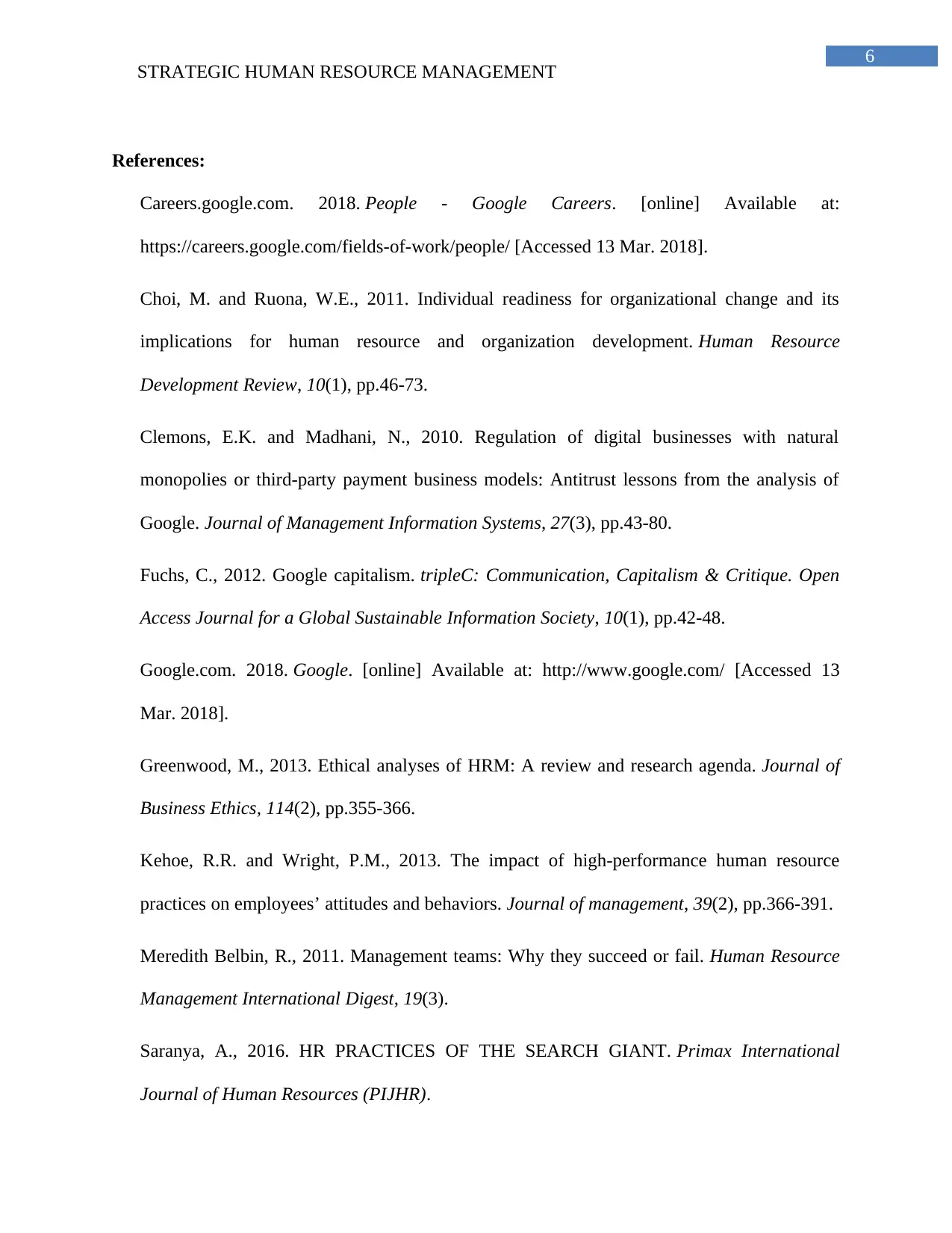
6
STRATEGIC HUMAN RESOURCE MANAGEMENT
References:
Careers.google.com. 2018. People - Google Careers. [online] Available at:
https://careers.google.com/fields-of-work/people/ [Accessed 13 Mar. 2018].
Choi, M. and Ruona, W.E., 2011. Individual readiness for organizational change and its
implications for human resource and organization development. Human Resource
Development Review, 10(1), pp.46-73.
Clemons, E.K. and Madhani, N., 2010. Regulation of digital businesses with natural
monopolies or third-party payment business models: Antitrust lessons from the analysis of
Google. Journal of Management Information Systems, 27(3), pp.43-80.
Fuchs, C., 2012. Google capitalism. tripleC: Communication, Capitalism & Critique. Open
Access Journal for a Global Sustainable Information Society, 10(1), pp.42-48.
Google.com. 2018. Google. [online] Available at: http://www.google.com/ [Accessed 13
Mar. 2018].
Greenwood, M., 2013. Ethical analyses of HRM: A review and research agenda. Journal of
Business Ethics, 114(2), pp.355-366.
Kehoe, R.R. and Wright, P.M., 2013. The impact of high-performance human resource
practices on employees’ attitudes and behaviors. Journal of management, 39(2), pp.366-391.
Meredith Belbin, R., 2011. Management teams: Why they succeed or fail. Human Resource
Management International Digest, 19(3).
Saranya, A., 2016. HR PRACTICES OF THE SEARCH GIANT. Primax International
Journal of Human Resources (PIJHR).
STRATEGIC HUMAN RESOURCE MANAGEMENT
References:
Careers.google.com. 2018. People - Google Careers. [online] Available at:
https://careers.google.com/fields-of-work/people/ [Accessed 13 Mar. 2018].
Choi, M. and Ruona, W.E., 2011. Individual readiness for organizational change and its
implications for human resource and organization development. Human Resource
Development Review, 10(1), pp.46-73.
Clemons, E.K. and Madhani, N., 2010. Regulation of digital businesses with natural
monopolies or third-party payment business models: Antitrust lessons from the analysis of
Google. Journal of Management Information Systems, 27(3), pp.43-80.
Fuchs, C., 2012. Google capitalism. tripleC: Communication, Capitalism & Critique. Open
Access Journal for a Global Sustainable Information Society, 10(1), pp.42-48.
Google.com. 2018. Google. [online] Available at: http://www.google.com/ [Accessed 13
Mar. 2018].
Greenwood, M., 2013. Ethical analyses of HRM: A review and research agenda. Journal of
Business Ethics, 114(2), pp.355-366.
Kehoe, R.R. and Wright, P.M., 2013. The impact of high-performance human resource
practices on employees’ attitudes and behaviors. Journal of management, 39(2), pp.366-391.
Meredith Belbin, R., 2011. Management teams: Why they succeed or fail. Human Resource
Management International Digest, 19(3).
Saranya, A., 2016. HR PRACTICES OF THE SEARCH GIANT. Primax International
Journal of Human Resources (PIJHR).
1 out of 7
Related Documents
Your All-in-One AI-Powered Toolkit for Academic Success.
+13062052269
info@desklib.com
Available 24*7 on WhatsApp / Email
![[object Object]](/_next/static/media/star-bottom.7253800d.svg)
Unlock your academic potential
Copyright © 2020–2025 A2Z Services. All Rights Reserved. Developed and managed by ZUCOL.





